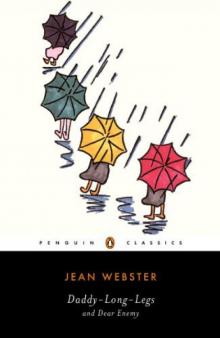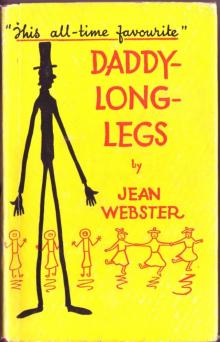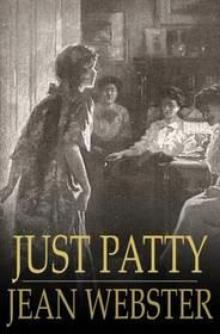- Home
- Jean Webster
Daddy-Long-Legs & Dear Enemy
Daddy-Long-Legs & Dear Enemy Read online
Table of Contents
Title Page
Copyright Page
Introduction
DADDY-LONG-LEGS
TO YOU
THE LETTERS OF MISS JERUSHA ABBOTT to MR. DADDY-LONG-LEGS SMITH
DEAR ENEMY
Explanatory Notes
DADDY-LONG-LEGS and DEAR ENEMY
JEAN WEBSTER was born Alice Jane Chandler Webster in 1876 and grew up in Fredonia, New York, and in New York City. A grand-niece of Mark Twain, Webster attended Vassar College, where she developed an interest in orphanages and social welfare and began to pursue a literary career. Her interest in both continued after her graduation in 1901, especially when she moved to New York’s Greenwich Village. She published stories and articles in newspapers and in magazines, including McClure’s. Her first novel, When Patty Went to College, came out in 1903, and was followed by The Wheat Princess (1905), Jerry Junior (1907), The Four Pools Mystery (1908), Much Ado About Peter (1909), and Just Patty (1911). In 1912 Webster published Daddy-Long-Legs, the novel that brought her great popular acclaim as well as financial security when she adapted it into a stage play in 1914. It later became the basis for several movies. The novel’s sequel, Dear Enemy, appeared in 1915. Also in 1915, Jean Webster married lawyer and Standard Oil Company heir Glenn Ford McKinney, some seven years after they began their affair (and a few months after his divorce was final). She died the following year, shortly after giving birth to their daughter, who survived.
ELAINE SHOWALTER is the author of the groundbreaking A Literature of Their Own and other books including Teaching Literature, Inventing Herself, Hystories, Sexual Anarchy, and The Female Malady, and the editor of volumes including the Penguin Classics editions of Louisa May Alcott’s Little Women and George Gissing’s The Odd Women. Her articles have appeared in an array of publications, including the Times Literary Supplement and People. She is professor emerita of English at Princeton University and now lives in Washington, D.C., and London.
PENGUIN BOOKS
Published by the Penguin Group
Penguin Group (USA) Inc., 375 Hudson Street,
New York, New York 10014, U.S.A.
Penguin Books Ltd, 80 Strand,
London, WC2R 0RL, England
Penguin Books Australia Ltd, 250 Camberwell Road, Camberwell,
Victoria 3124, Australia
Penguin Books Canada Ltd, 10 Alcorn Avenue,
Toronto, Ontario, Canada M4V 3B2
Penguin Books India (P) Ltd, 11 Community Centre, Panchsheel Park,
New Delhi - 110 017, India
Penguin Books (NZ), Cnr Airborne and Rosedale Roads, Albany,
Auckland 1310, New Zealand
Penguin Books (South Africa) (Pty) Ltd, 24 Sturdee Avenue,
Rosebank, Johannesburg 2196, South Africa
Penguin Books Ltd, Registered Offices:
80 Strand, London, WC2R 0RL, England
Daddy-Long-Legs first published in the United States of America by The Century Co. 1912
Dear Enemy first published in the United States of America by The Century Co. 1915
This edition with an introduction and notes by Elaine Showalter published in Penguin Books 2004
Introduction and notes copyright © Elaine Showalter, 2004
All rights reserved
LIBRARY OF CONGRESS CATALOGING-IN-PUBLICATION DATA
Webster, Jean, 1876-1916.
Daddy Long Legs ; and, Dear enemy / Jean Webster ; edited with an introduction
and notes by Elaine Showalter.
p. cm.
Includes bibliographical references.
eISBN : 978-1-101-49557-5
1. Women college students—Fiction. 2. Philanthropists—Fiction. 3. Women authors—Fiction.
4. Young women—Fiction. 5. Orphans—Fiction. I. Showalter, Elaine.
II. Webster, Jean, 1876-1916. Dear enemy. III. Title: Dear enemy. IV. Title.
PS3545.E365D3 2004
813’.52—dc22 2004048210
The scanning, uploading, and distribution of this book via the Internet or via any other means without
the permission of the publisher is illegal and punishable by law. Please purchase only authorized electronic
editions and do not participate in or encourage electronic piracy of copyrighted materials.
Your support of the author’s rights is appreciated.
http://us.penguingroup.com
Introduction
Jean Webster’s Daddy-Long-Legs (1912) and its sequel, Dear Enemy (1915), come from a literary era in which best-selling American woman writers like Kate Douglas Wiggin (Rebecca of Sunnybrook Farm), Eleanor H. Porter (Pollyanna), and Gene Stratton-Porter (A Girl of the Limberlost) created sentimental girl heroines. In contrast, one of the truly modern qualities of Webster’s writing is its lack of sentimentality and preachiness. Although her heroines Judy and Sallie are idealistic reformers, they are also irreverent and irrepressible; although they are staunch feminists, they also take great pleasure in kid gloves, new dresses, and male company. The epistolary format of these two novels allows the liveliness of women’s letter-writing to cloak the radical notions of women’s limitless strength and capability.
In many respects, Webster’s novels are in the great American tradition of Louisa May Alcott’s fiction. Like Jo March in Little Women, which Judy mentions among the books she is reading in Daddy-Long-Legs, Judy aspires to be a writer, and must discard both the patriarchal models of her education and the sensational stories of her imagination before she realizes that her own experience is her best material, and finds her own voice. Like Jo in the sequels, Little Men and Jo’s Boys, Sallie McBride in Dear Enemy discovers that running a model institution for children is more interesting than romance; “I see marriage as a man must,” writes Sallie, “a good, sensible workaday institution; but awfully curbing to one’s liberty.”
Finally, like Jo, both Judy and Sallie find happiness with men who will accept and support their yearning to work. Although each novel ends with a predictable love scene, these seem almost an afterthought, for the action of these novels comes not from Judy Abbott’s and Sallie McBride’s search for a strong man, but from their discoveries of their own strength. They are unconventional New Women, as well as independent American girls; indeed, Sallie muses, “one man doesn’t seem quite enough for me.”
Daddy-Long-Legs, the most popular of Jean Webster’s books, is both a love story and a Künstlerroman—an autobiographical account of an artist’s development. Rescued from the dreary wasteland of the John Grier Home for orphans by an anonymous philanthropist, Jerusha Abbott (whose solemn name the director of the Home has selected from the phone book and the cemetery) is sent to college with her benefactor’s express intent that she should be educated “to become a writer.” A John Grier Trustee, he has read her essay “Blue Wednesday,” describing the “Perfectly Awful Day” of the month, the first Wednesday, on which the trustees and their ladies come to hear reports and to inspect their charges. “Blue Wednesday” is satiric and “impertinent,” but luckily the Trustee has a sense of humor and finds it original. We can judge it a bit ourselves, because “Blue Wednesday” is also the first chapter of the novel, and the only one written in the third person.
The trustee wishes to be anonymous, and insists only that Jerusha send him monthly letters of her progress, addressed to “Mr. John Smith,” because “he thinks nothing so fosters facility in literary expression as letter-writing.” But he will never reply, because he himself detests writing letters, and does not care for girls. Thereafter, the story is told through the lively letters of the heroine, and illustrated with her cartoons and drawings. She begins by renaming herself “Judy” and giving her benefa
ctor the nickname “Daddy-Long-Legs” because she has caught a glimpse of his shadow, with “grotesquely elongated legs and arms.” (Webster glosses over Judy’s lack of initiative in figuring out who he is—surely the John Grier Home cannot have anonymous trustees.) But by the novel’s end, after her graduation from college, not only has Judy discovered Daddy-Long-Legs’ identity and found her true love, but she has also sold her first novel. Finally, she reflects upon a Blue Wednesday from the vantage point of her last semester of college, and concludes that being an orphan was “a very unusual adventure” that has given her “a perspective on the world, that other people, who have been brought up in the thick of things, entirely lack.”
Webster weaves Judy’s road to authorship through her letters to Daddy-Long-Legs. She buys five hundred sheets of yellow manuscript paper with his first Christmas present, and regularly wins literary prizes and publications in college; a poem, “From My Tower,” as a freshman; the short-story competition as a sophomore; another story and a scholarship for “marked proficiency in English” the same year. As a junior, she tries writing a novel based on her two-week holiday trip to New York, but it is rejected as “improbable” and “unnatural.” She burns it, and dreams that she is holding a book called “The Life and Letters of Judy Abbott,” with a picture of the John Grier Home on the cover. By her senior year, she realizes that her own life is her true subject. “I’m a realist now,” she explains. “I’ve abandoned romanticism; I shall go back to it later though, when my own adventurous future begins.” And when she decides to marry, she realizes that she can keep on being a writer: “the two professions are not necessarily exclusive.”
How much of a realist was Jean Webster? Many of the themes and details of the two novels are autobiographical, but Webster’s life was much more privileged and cosmopolitan. Born in 1876 to Charles Luther and Annie (Moffet) Webster, Alice Jane Chandler Webster enjoyed a comfortable childhood in Fredonia, New York. In 1884, her father became the business partner and publisher of Mark Twain, his wife’s uncle, and moved the family to Manhattan, where he directed the Charles L. Webster Publishing Company. Publishing such best-sellers as The Adventures of Huckleberry Finn and General Ulysses S. Grant’s overwhelmingly successful Personal Memoirs, Charles Webster met both great success and stressful responsibility. He developed severe headaches, a form of nervous breakdown, and had to move back to the country. After his recovery, Twain refused to take him back, charged him with poor management, and bought him out for less than his shares were worth. Charles Webster committed suicide in 1891, when his daughter was fifteen. According to Karen Alkalay-Gut, “the rest of [Jean Webster’s] life, in many ways, exhibited a protest against patriarchal authority, authoritative systems, and authoritative individuals, and an examination of alternatives to destructive authoritative systems is her constant concern in almost every aspect of her life and writing.”1
From 1894 to 1896, she attended a boarding school—The Lady Jane Grey School at Binghamton—where she renamed herself Jean because her roommate’s name was Alice as well. But the education offered by a finishing school was not enough to satisfy her intellectual curiosity and her nascent spirit of social reform. In 1897, she entered Vassar College with the class of 1901 to study English and economics. She wrote a number of stories for the Vassar literary magazine, Vassar Miscellany. In her sophomore year, Webster roomed with the future poet Adelaide Crapsey (with whom she carried the socialist banner in a campus parade), and the class president, Margaret Jackson. She also spent a semester of her junior year abroad in Greece, England, and Italy, researching a paper on poverty in Italy. Meanwhile, she wrote a column for the Poughkeepsie Sunday Courier, for which she earned $3 per week. As the paper later noted, “Miss Webster was the correspondent for The Courier while a student at the college and her letters will be remembered by our readers for the atmosphere of cheerfulness that characterized them. No humorous incident at the college ever escaped Miss Webster’s attention. At the same time there was no lack of dignity when serious subjects were under consideration. In addition to her correspondence Miss Webster also contributed a series of articles to The Courier covering her experiences while travelling in Europe.”2
There are many elements of her Vassar experience in Daddy-Long-Legs. During her four years as an undergraduate, Vassar was a college of six hundred women, predominantly Republican in their leanings, while Webster was already a socialist. The college did not support women’s suffrage or allow the students to participate in suffrage activism. But Vassar was already becoming known as a literary center; Edna St. Vincent Millay chose it over Smith when she entered as a scholarship student in 1913 (with a monthly allowance of $20, compared to the munificent $35 Judy Abbott receives from her patron). In her English class, Judy is expected to comment on a poem by Emily Dickinson (she is baffled)—an indication of how sophisticated the syllabus was for the period. She also participates in the Field Day athletic competitions between the classes, instituted at Vassar in 1895; and she describes the construction of a new dormitory and the infirmary. Most important, she describes herself as a Fabian socialist, one who is willing to wait while “instituting industrial, educational and orphan asylum reforms.” In 1898, Sidney and Beatrice Webb, two of the founders of the British Fabian Society, had spoken at Vassar about “The Scope of Democracy in England.”3
After her 1901 graduation, Webster energetically pursued a literary career. She published her first piece, an article and photographs about Monte Carlo, in 1902 in the Buffalo Express, under the pseudonym “Carly Ward.” For the next several years, Webster regularly submitted stories to various magazines, persisting despite frequent rejection, and within a few years she was selling to McClure’s and other periodicals. Her first book, When Patty Went to College, came out in 1903. Mark Twain read it and congratulated her mother: “It is limpid, bright, sometimes brilliant; it is easy, flowing, effortless, and brimming with girlish spirits.”4 In November 1903, Webster took off again for Rome, where she visited the graves of Keats and Shelley, and stayed at a convent. She continued to publish stories and novels—The Wheat Princess (1905) and Jerry Junior (1907).
In November 1907, Webster embarked on a year-long journey around the world with her friends Ethelyn McKinney, daughter of the president of the Standard Oil Company of Pennsylvania, and Lena Weinstein, a New York art critic. They visited Egypt, India, China, Japan, Burma, and Ceylon; in a society clipping in her files, the reporter notes that “She is planning, evidently, for very warm weather, for the main portion of her wardrobe consists of twenty-five white dresses.”5 Such a trip and such a wardrobe were hardly the hallmarks of the bohemian, but Jean was much more daring than she may have appeared. In the summer of 1908, she fell in love with a married man—Ethelyn’s brother, the lawyer and Standard Oil Company heir Glenn Ford McKinney. A graduate of Princeton, class of 1891, McKinney was married and had a son; his wife, Annette, had suffered periodic attacks of manic depression. In July 1908, Webster and McKinney began a long-term secret affair. According to Anne Bower, Webster’s almost daily letters to him “were a study of good cheer, chattiness, and constancy as she encouraged him to fight alcoholism and the frustration of work he did not enjoy.” In July 1913 she wrote to him: “Our salvation is work and work and more work. Fortunately we both have some ready to our hands. Set to work with all promptitude and cheerfulness at your farm and accomplish as much as possible against the time when I can look at it with you.”6 Louisa May Alcott could not have put the case for work and duty better.
But Webster was not just a workaholic stoic. On her return from Europe, she settled in Greenwich Village, on West 10th Street. The path from Vassar to the Village was well-trod by feminists, including the suffragists Crystal Eastman and Inez Mulholland. Randolph Bourne aptly described the feminist bohemians of the period to a friend thinking of moving to Greenwich Village: “They are all social workers, or magazine writers in a small way. They are decidedly emancipated and advanced, and so thoroughly healthy and zest
ful, or at least so it seems to my unsophisticated masculine sense. They shock you constantly.... They have an amazing combination of wisdom and youthfulness, of humor and ability, and innocence and self-reliance, which absolutely belies everything you will read in the story-books or any other description of womankind. They are, of course, all self-supporting and independent; and they enjoy the adventure of life.”7
Webster was part of this generation. While living in New York and writing, she also became more involved with aiding the unfortunate, continuing an interest that had begun in college when she visited institutions for the destitute and delinquent as part of an economics course. She served on committees for prison reform and worked with Sing-Sing convicts. She defined herself as a socialist and marched in the Women’s Suffrage May Day parade, but her tactics were usually playful rather than militant. In the spring of 1909, for example, she received a notice demanding that “Jean Webster, Author” appear for jury duty. Of course, women were not allowed to serve on juries in New York or most states, a form of legal discrimination which elicited protest from feminist writers such as Susan Glaspell, in her story “A Jury of Her Peers.” Suffragist friends urged Webster to try to be seated on a jury. Instead, she wrote back on her most feminine stationery (“pale tinted paper, scented with violets”):
Dear Sir. If you really wish it I shall be delighted to serve on the jury. I have always thought that it would be an interesting experience, but I had never hoped to be invited. The opportunity is very apropos, as I am thinking of having a courtroom scene in my next story, and it will be an excellent opportunity to study local color. Thank you so much for asking me. I am going to the country in June, so that I should not be able to serve then, but any time in May would be convenient, except for Saturday, which is my day at home.

 Daddy-Long-Legs & Dear Enemy
Daddy-Long-Legs & Dear Enemy Daddy-Long-Legs
Daddy-Long-Legs The Wheat Princess
The Wheat Princess Jerry
Jerry Just Patty
Just Patty